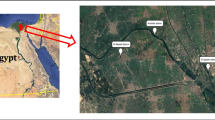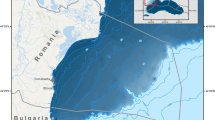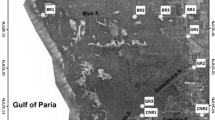Abstract
The coastal population in East Africa is growing rapidly but sewage treatment and recycling facilities in major cities and towns are poorly developed. Since estuarine mangroves are the main hotspots for pollutants, there is a potential for contaminants to accumulate in edible fauna and threaten public health. This study analysed trace metals in muscle tissues of the giant mud crabs (Scylla serrata) and the giant tiger prawns (Penaeus monodon) from the Tanzanian coast, in order to determine the extent of bioaccumulation and public health risks. A total of 180 samples of muscle tissues of S. serrata and 80 of P. monodon were collected from nine sites along the coast. Both species showed high levels of trace metals in the wet season and significant bioaccumulation of As, Cu and Zn. Due to their burrowing and feeding habits, mud crabs were more contaminated compared to tiger prawns sampled from the same sites. Apart from that, the measured levels of Cd, Cr and Pb did not exceed maximum limits for human consumption. Based on the current trend of fish consumption in Tanzania (7.7 kg/person/year), the measured elements (As, Cd, Co, Cu, Mn, Pb and Zn) are not likely to present health risks to shellfish consumers. Nevertheless, potential risks of As and Cu cannot be ruled out if the average per capita consumption is exceeded. This calls for strengthened waste management systems and pollution control measures.





Similar content being viewed by others
References
Ahearn, G. A., Mandal, P. K., & Mandal, A. (2004). Mechanisms of heavy metal sequestration and detoxification in crustaceans: a review. Journal of Comparative Physiology B, 174(6), 439–452. https://doi.org/10.1007/s00360-004-0438-0.
Alberts-Hubatsch, H., Lee, S. Y., Meynecke, J.-O., Diele, K., Nordhaus, I., & Wolff, M. (2016). Life-history, movement, and habitat use of Scylla serrata (Decapoda, Portunidae): current knowledge and future challenges. Hydrobiologia, 763, 5–21. https://doi.org/10.1007/s10750-015-2393-z.
Antoine, J. M. R., Fung, L. A. H., & Grant, C. N. (2017). Assessment of the potential health risks associated with the aluminium, arsenic, cadmium and lead content in selected fruits and vegetables grown in Jamaica. Toxicology Reports, 4, 181–187. https://doi.org/10.1016/j.toxrep.2017.03.006.
BET, (Board of External Trade). (2003). The fish sector export development strategy. In Dar es Salaam. Tanzania: Microcomputer Power.
Calatayud, M., & Llopis, J. M. L. (2015). Arsenic through the gastrointestinal tract. In S. J. S. Flora (Ed.), Handbook of Arsenic Toxicology (1st ed., pp. 281–299). San Diego: Elsevier Inc..
De Wolf, H., Ulomi, S. A., Backeljau, T., Pratap, H. B., & Blust, R. (2001). Heavy metal levels in the sediments of four Dar es Salaam mangroves. Accumulation in, and effect on the morphology of the periwinkle, Littoraria scabra (Mollusca: Gastropoda). Environment International, 26(4), 243–249.
Deb, S. C., & Fukushima, T. (1999). Metals in aquatic ecosystems: mechanisms of uptake, accumulation and release-ecotoxicological perspectives. International Journal of Environmental Studies, 56(3), 385–417. https://doi.org/10.1080/00207239908711212.
EC. (2011). Commission regulation (EC) No 420/2011 of 29 April 2011: amending regulation (EC) No 1881/2006 setting maximum levels for certain contaminants in foodstuffs. Official Journal of the European Union, L, 111, 3–6.
EC. (2014). Commission regulation (EC) No 488/2014 of 12 May 2014: amending regulation (EC) No 1881/2006 as regards maximum levels of cadmium in foodstuffs. Official Journal of the European Union, L, 138, 75–79. https://doi.org/10.2903/j.efsa.2011.1975.
Garcia, S. (1988). Tropical penaeid prawns. In J. A. Gulland (Ed.), Fish Population Dynamics (2nd ed., pp. 219–249). Chichester: Wiley and Sons Ltd..
Hellar-Kihampa, H., Potgieter-Vermaak, S., Van Meel, K., Rotondo, G. G., Kishimba, M., & Van Grieken, R. (2012). Elemental composition of bottom-sediments from Pangani river basin, Tanzania: lithogenic and anthropogenic sources. Toxicological and Environmental Chemistry, 94, 525–544. https://doi.org/10.1080/02772248.2011.648940.
Hossain, M. S., & Khan, Y. S. A. (2001). Trace metals in Penaeid shrimp and Spiny lobster from the Bay of Bengal. ScienceAsia, 27, 165–168.
Kamaruzzaman, B. Y., Akbar John, B., Maryam, B. Z., Jalal, K. C. A., & Shahbuddin, S. (2012). Bioaccumulation of heavy metals (Cd, Pb, Cu and Zn) in Scylla serrata (Forsskal 1775) collected from Sungai Penor, Pahang, Malaysia. Pertanika Journal of Tropical Agricultural Science, 35(1), 183–190.
Kamau, J. N., Kuschk, P., Machiwa, J., Macia, A., Mothes, S., Mwangi, S., et al. (2015). Investigating the distribution and fate of Al, Cd, Cr, Cu, Mn, Ni, Pb and Zn in sewage-impacted mangrove-fringed creeks of Kenya, Tanzania and Mozambique. Journal of Soils and Sediments, 15, 2453–2465. https://doi.org/10.1007/s11368-015-1214-3.
Kihampa, C. (2013). Heavy metal contamination in water and sediment downstream of municipal wastewater treatment plants, Dar es Salaam, Tanzania. International Journal of Environmental Sciences, 3(5), 1407–1415. https://doi.org/10.6088/ijes.2013030500011.
Krishnamurti, A. J., & Nair, V. R. (1999). Concentration of metals in shrimps and crabs from Thane-Bassein creek system, Maharashtra. Indian Journal of Marine Sciences, 28, 92–95.
Kruitwagen, G., Pratap, H. B., Covaci, A., & Wendelaar Bonga, S. E. (2008). Status of pollution in mangrove ecosystems along the coast of Tanzania. Marine Pollution Bulletin, 56(5), 1022–1042. https://doi.org/10.1016/j.marpolbul.2008.02.018.
Kumar, V., Sinha, A. K., Rodrigues, P. P., Mubiana, V. K., Blust, R., & De Boeck, G. (2015). Linking environmental heavy metal concentrations and salinity gradients with metal accumulation and their effects: a case study in 3 mussel species of Vitória estuary and Espírito Santo bay, Southeast Brazil. Science of the Total Environment, 523, 1–15. https://doi.org/10.1016/j.scitotenv.2015.03.139.
Kyomo, J. (1999). Distribution and abundance of crustaceans of commercial importance in Tanzania mainland coastal waters. Bulletin of Marine Science, 65(2), 321–335.
Machiwa, J. F. (2003). Metal concentrations in sediment and fish of Lake Victoria near and away from catchments with gold mining activities. Tanzania Journal of Science, 29(2), 43–54.
Machiwa, J. F. (2005). Metals in Nile perch (Lates niloticus) and suspended particulate matter from Lake Victoria, Tanzania. Journal of Environmental Science and Health, 40(9), 1809–1822. https://doi.org/10.1081/Ese-200068063.
Mdegela, R. H., Braathen, M., Pereka, A. E., Mosha, R. D., Sandvik, M., & Skaare, J. U. (2009). Heavy metals and organochlorine residues in water, sediments, and fish in aquatic ecosystems in urban and peri-urban areas in Tanzania. Water, Air, and Soil Pollution, 203(1–4), 369–379. https://doi.org/10.1007/s11270-009-0019-7.
Meshram, L. N., Udawant, S. M., Pawar, S., & Mishra, P. S. (2014). Bioaccumulation of heavy metals (Zn, Pb, Cd, and Ni) in tissues of Penaeus monodon (Fabricius, 1798) from India. International Journal of Advanced Research, 2(3), 548–555.
Mirera, D. H. O. (2009). Mud crab (Scylla serrata) culture: understanding the technology in a Silvofisheries perspective. Western Indian Ocean Journal of Marine Science, 8, 127–137. https://doi.org/10.4314/wiojms.v8i1.56681.
Mitra, A., Banerjee, K., Ghosh, R., & Ray, S. K. (2010). Bioaccumulation pattern of heavy metals in the shrimps of the lower stretch of the River Ganga. Mesopotamian Journal of Marine Science, 25(2), 1–14.
Mmochi, A., & Francis, J. (2003). Land based activities and sources of pollution to the marine, coastal and associated fresh water ecosystems in the Western Indian Ocean Region. Zanzibar. http://www.oceandocs.org/handle/1834/209. Accessed 14 July 2011.
Mohapatra, A., Rautray, T. R., Patra, A. K., Vijayan, V., & Mohanty, R. K. (2009). Elemental composition in mud crab Scylla serrata from Mahanadi estuary, India: in situ irradiation analysis by external PIXE. Food and Chemical Toxicology, 47(1), 119–123. https://doi.org/10.1016/j.fct.2008.10.016.
Mortimer, M. R. (2000). Pesticide and trace metal concentrations in Queensland Estuarine crabs. Marine Pollution Bulletin, 41, 359–366. https://doi.org/10.1016/S0025-326X(00)00136-3.
Mosha, E. J., & Gallardo, W. G. (2013). Distribution and size composition of penaeid prawns, Penaeus monodon and Penaeus indicus in Saadan estuarine area, Tanzania. Ocean and Coastal Management, 82, 51–63. https://doi.org/10.1016/j.ocecoaman.2013.05.003.
Mshana, J. G., & Sekadende, B. (2014). Assessment of heavy metal pollution in Octopus cyanea in the coastal waters of Tanzania. Journal of Health and Pollution, 6(6), 10–17.
Mtanga, A., & Machiwa, J. (2007). Assessment of heavy metal pollution in sediment and polychaete worms from the Mzinga creek and Ras Dege mangrove ecosystems, Dar es Salaam, Tanzania. Western Indian Ocean Journal of Marine Science, 6(2), 125–135.
Muñoz, O., Devesa, V., Suñer, M. A., Vélez, D., Montoro, R., Urieta, I., et al. (2000). Total and inorganic arsenic in fresh and processed fish products. Journal of Agricultural and Food Chemistry, 48(9), 4369–4376. https://doi.org/10.1021/jf000282m.
Oliveira, E. C., Österlund, K., & Mtolera, M. S. P. (2005). In N. Sporrong & M. Björk (Eds.), Marine plants of Tanzania: a field guide to the seaweeds and seagrasses of Tanzania. Stockholm: Sweden: Sida/Department for Research Cooperation, SAREC.
Ordiano-Flores, A., Galván-Magaña, F., & Rosiles-Martínez, R. (2011). Bioaccumulation of mercury in muscle tissue of yellowfin tuna, Thunnus albacares, of the eastern Pacific Ocean. Biological Trace Element Research, 144(1–3), 606–620. https://doi.org/10.1007/s12011-011-9136-4.
Peshut, P. J., Morrison, R. J., & Brooks, B. A. (2008). Arsenic speciation in marine fish and shellfish from American Samoa. Chemosphere, 71(3), 484–492. https://doi.org/10.1016/j.chemosphere.2007.10.014.
Piazza, V., Gambardella, C., Canepa, S., Costa, E., Faimali, M., & Garaventa, F. (2016). Temperature and salinity effects on cadmium toxicity on lethal and sublethal responses of Amphibalanus amphitrite nauplii. Ecotoxicology and Environmental Safety, 123, 8–17. https://doi.org/10.1016/j.ecoenv.2015.09.023.
PRC, (People’s Republic of China ). (2012). National food safety standard for maximum levels of contaminants in foods. Beijing: National Standard of the People’s Republic of China GB GB 2762–2012.
Rainbow, P. S. (1997). Ecophysiology of trace metal uptake in Crustaceans. Estuarine, Coastal and Shelf Science, 44(2), 169–175. https://doi.org/10.1006/ecss.1996.0208.
Rainbow, P. S. (2002). Trace metal concentrations in aquatic invertebrates: why and so what? Environmental Pollution, 120(3), 497–507. https://doi.org/10.1016/S0269-7491(02)00238-5.
Rainbow, P. S., & Black, W. H. (2002). Effects of changes in salinity and osmolality on the rate of uptake of zinc by three crabs of different ecologies. Marine Ecology Progress Series, 244, 205–217. https://doi.org/10.3354/meps244205.
Rumisha, C., Elskens, M., Leermakers, M., & Kochzius, M. (2012). Trace metal pollution and its influence on the community structure of soft bottom molluscs in intertidal areas of the Dar es Salaam coast, Tanzania. Marine Pollution Bulletin, 64, 521–531.
Rumisha, C., Shukuru, H., Lyimo, J., Maganira, J., & Nehemia, A. (2015). Benthic macroinvertebrate assemblages in mangroves and open intertidal areas on the Dar es Salaam coast, Tanzania. African Journal of Aquatic Science, 40(2), 143–151. https://doi.org/10.2989/16085914.2015.1051504.
Rumisha, C., Mdegela, R. H., Kochzius, M., Leermakers, M., & Elskens, M. (2016). Trace metals in the giant tiger prawn Penaeus monodon and mangrove sediments of the Tanzania coast: is there a risk to marine fauna and public health? Ecotoxicology and Environmental Safety, 132, 77–86. https://doi.org/10.1016/j.ecoenv.2016.05.028.
Saria, J. A. M. (2017). Assessment of human health hazard due to metal uptake via fish consumption from coastal area of Tanzania. Ethiopian Journal of Environmental Studies and Management, 10(4), 555–565.
Sarkar, T., Alam, M. M., Parvin, N., Fardous, Z., Chowdhury, A. Z., Hossain, S., et al. (2016). Assessment of heavy metals contamination and human health risk in shrimp collected from different farms and rivers at Khulna-Satkhira region, Bangladesh. Toxicology Reports, 3, 346–350. https://doi.org/10.1016/j.toxrep.2016.03.003.
Shazili, N. A. M. (1995). Effects of salinity and pre-exposure on acute cadmium toxicity to seabass, Lates calcarifer. Bulletin of Environmental Contamination and Toxicology, 54(1), 22–28. https://doi.org/10.1007/BF00196265.
Sriket, P., Benjakul, S., Visessanguan, W., & Kijroongrojana, K. (2007). Comparative studies on chemical composition and thermal properties of black tiger shrimp (Penaeus monodon) and white shrimp (Penaeus vannamei) meats. Food and Chemical Toxicology, 103, 1199–1207. https://doi.org/10.1016/j.foodchem.2006.10.039.
Taylor, M., Ravilious, C., & Green, E. P. (2003). Mangroves of East Africa. Cambridge: UNEP-WCMC.
Tu, P. N. C., Ha, N. N., Ikemoto, T., & Tuyen, B. C. (2008). Regional variations in trace element concentrations in tissues of black tiger shrimp Penaeus monodon (Decapoda: Penaeidae) from South Vietnam. Marine Pollution Bulletin, 57, 858–866. https://doi.org/10.1016/j.marpolbul.2008.02.016.
URT, (United Republic of Tanzania). (2013). 2012 Population and housing cencus. Tanzania: Dar es Salaam.
URT, (United Republic of Tanzania). (2016). The Tanzanian fisheries sector: challenges and opportunities. Tanzania: Dar es Salaam.
US EPA. (2016). Regional screening levels (RSLs)—generic tables (May 2016). Arlington, Virginia. https://www.epa.gov/risk/regional-screening-levels-rsls-generic-tables-may-2016
Usero, J., Morillo, J., & Gracia, I. (2005). Heavy metal concentrations in molluscs from the Atlantic coast of southern Spain. Chemosphere, 59(8), 1175–1181. https://doi.org/10.1016/j.chemosphere.2004.11.089.
van Oosterom, J., Codi King, S., Negri, A., Humphrey, C., & Mondon, J. (2010). Investigation of the mud crab (Scylla serrata) as a potential bio-monitoring species for tropical coastal marine environments of Australia. Marine Pollution Bulletin, 60(2), 283–290. https://doi.org/10.1016/j.marpolbul.2009.09.007.
Verslycke, T., Vangheluwe, M., Heijerick, D., De Schamphelaere, K., Van Sprang, P., & Janssen, C. R. (2003). The toxicity of metal mixtures to the estuarine mysid Neomysis integer (Crustacea: Mysidacea) under changing salinity. Aquatic Toxicology, 64(3), 307–315. https://doi.org/10.1016/S0166-445X(03)00061-4.
Wang, W. (1987). Factors affecting metal toxicity to (and accumulation by) aquatic organisms - overview. Environment International, 13(6), 437–457.
Wang, Z., Yan, C., Pan, Q., & Yan, Y. (2011). Concentrations of some heavy metals in water, suspended solids, and biota species from Maluan Bay, China and their environmental significance. Environmental Monitoring and Assessment, 175, 239–249. https://doi.org/10.1007/s10661-010-1509-1.
WHO. (2011a). Evaluation of certain contaminants in food: seventy-second report of the joint FAO/WHO expert committee on food additives. WHO technical report series 959. Geneva. http://apps.who.int/iris/bitstream/10665/44514/1/WHO_TRS_959_eng.pdf.
WHO. (2011b). Evaluation of certain food additive and contaminants: seventy-third report of the joint FAO/WHO expert committee on food additives. WHO technical report series 960 (Vol. 960). Geneva. http://apps.who.int/iris/bitstream/10665/44515/1/WHO_TRS_960_eng.pdf.
Wold Bank. (2008). Putting Tanzania’s hidden economy to work: reform, management, and protection of its natural resource sector. World Bank Country Study. Washington D,C: World Bank. https://doi.org/10.1596/978-0-8213-7462-7.
Acknowledgements
The authors are very thankful to the Ministry of Agriculture, Livestock and Fisheries of the United Republic of Tanzania for providing permits to export samples. Fishermen and fishery officers in the study area are gratefully acknowledged for their support during sampling. Last but not least, the authors are very thankful to the associate editor and the two anonymous reviewers for their constructive remarks.
Funding information
This study was funded by VLIR-UOS (Vlaamse Interuniversitaire Raad – Universitaire Ontwikkelingssamenwerking: grant number ICP PhD 2013-009). The funder had no role in study design, data collection and analysis, or preparation of the manuscript.
Author information
Authors and Affiliations
Corresponding author
Rights and permissions
About this article
Cite this article
Rumisha, C., Leermakers, M., Mdegela, R.H. et al. Bioaccumulation and public health implications of trace metals in edible tissues of the crustaceans Scylla serrata and Penaeus monodon from the Tanzanian coast. Environ Monit Assess 189, 529 (2017). https://doi.org/10.1007/s10661-017-6248-0
Received:
Accepted:
Published:
DOI: https://doi.org/10.1007/s10661-017-6248-0




